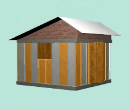The Cecat Experience and the story of the Tevi equipment

Cecat, the "Center for Construction and Tropical Architecture at the Technical University of Havana learned about MicroConcrete Roofing (MCR) technology early in 1991. In the midst of the crisis called the special period, it became clear that Cuba would opt for MCR, as national authorities concerned with construction and housing were pleased to encounter a viable roofing alternative.
by Kurt Rhyner
Cecat first sought a favorable commercial agreement with the market leader for either bulk orders or licensed production, to no avail. In October of 1991 at the First Latin American MCR Seminar in the Dominican Republic, Cuban delegates along with those from 10 other countries requested that reliable equipment become available at low prices and with terms of credit. Both equipment producers present (a European and a South American) clearly stated that they could not respond to this request. This was the signal to Cecat to begin to develop its own equipment.
 Ruben Bancrofft and Jorge Acevedo, who just had finished a thorough series of tests on MCR tiles, took on direction of this task. Together with specialists from within Cecat and from the Mechanical Engineering Faculty they designed a new type of machine, based upon a rotating vibrating table to significantly speed up production.
Ruben Bancrofft and Jorge Acevedo, who just had finished a thorough series of tests on MCR tiles, took on direction of this task. Together with specialists from within Cecat and from the Mechanical Engineering Faculty they designed a new type of machine, based upon a rotating vibrating table to significantly speed up production.
A first prototype provided the basis for construction of a second, and a third version was to follow. However, in Holguin the provincial government decided to go ahead with tile production; they did not want to wait any longer, as more than one year had passed since they first learned about MCR tiles. Given the urgency to respond to market requests throughout Latin America, Cecat also decided to go ahead with the original single table machine. Once a prototype was successfully in operation, a well-equipped commercial company took on production of the first series of vibrators.
 As everyone was clear that tooling to manufacture moulds was a major cost factor, no experiments were to be made there. Good moulds were examined, their form computer-analyzed and cross-sections inspected. It became clear that although the shape was good, the moulds were not quite as perfect as everyone had believed. After long discussions between the directorate of Cecat and the engineers it was decided to produce a mould which would be compatible with the market leader, but which would eliminate the small problems which had been detected. The new mould would produce tiles which are conical so as to provide a better fit for 8 and 10 mm tiles, and which would have to be stronger than the British product.
As everyone was clear that tooling to manufacture moulds was a major cost factor, no experiments were to be made there. Good moulds were examined, their form computer-analyzed and cross-sections inspected. It became clear that although the shape was good, the moulds were not quite as perfect as everyone had believed. After long discussions between the directorate of Cecat and the engineers it was decided to produce a mould which would be compatible with the market leader, but which would eliminate the small problems which had been detected. The new mould would produce tiles which are conical so as to provide a better fit for 8 and 10 mm tiles, and which would have to be stronger than the British product.
Actual production of the injection mould was quick and unproblematic because factories from pre-crisis times existed and with their modern equipment were able to take on the task. One firm was involved in design and tooling, another in the injection technology. However, it did cost Cecat some $40,000 cash, apart from the previous engineering work done by CECAT and the commercial companies. The specialists rapidly identified the proper type and quality of raw material and production of moulds began on the most modern equipment available with an injection force of more than 100 tons.
 "Tevi" stands for "Teja Vibrada" (vibrated tiles) and is produced in Havana under the guidance of Cecat. Around $50,000 had been spent in cash and again as much in engineering costs, that is considering low local salaries.
"Tevi" stands for "Teja Vibrada" (vibrated tiles) and is produced in Havana under the guidance of Cecat. Around $50,000 had been spent in cash and again as much in engineering costs, that is considering low local salaries.
Demand for reasonable priced and reliable equipment in Latin America was so great that Cecat had to risk lancing the first production run on the basis of its local field testing. By March of 1993 the first "tevi" equipment was on the market.
From 1993 until 2007, some 300 equipments with a total of over 100,000 moulds were exported from Cuba to Latin America, Africa and Asia. Another 100,000 moulds were produced for the local market in Cuba.
Due to bottle-necks in production and export, EcoSur has started to produce moulds and vibrators in Ecuador and is now able to offer higher quality equipment at even lower prices, far below the European producer who did not want to enter into a business deal back in 1991.


